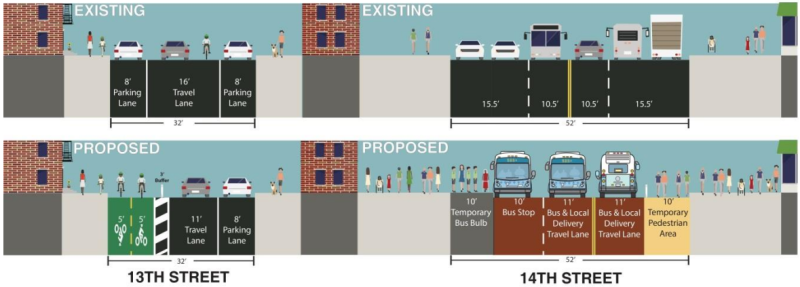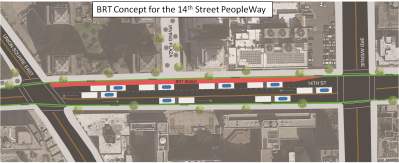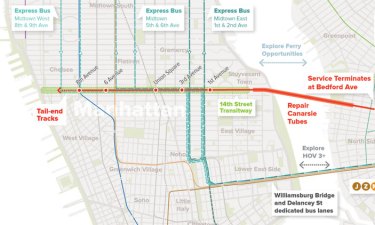There’s No Reasoning With the NIMBYs Opposed to a 14th Street Busway
The West Siders fighting measures to carve out street space for transit and biking simply "don't believe the numbers."

Unless DOT and the MTA carve out street space for the most spatially efficient modes of travel, the impending L train shutdown is going to unleash a traffic tsunami on the neighborhoods around 14th Street. Without fast, reliable buses and safe bikeways, the streets will be jammed with Ubers for 15 months.
Just try telling that to the West Village residents who turned up at an open house on the agencies’ L train shutdown plans last night.
Along 14th Street, there are currently 50,000 intra-Manhattan L train trips each weekday, according to the MTA, as well as about 30,000 trips on the M14. With the possible exception of 42nd Street, it is the most intensely traveled crosstown route in the borough.
The agencies’ plan calls for a bus- and deliveries-only section between Eighth Avenue and Third Avenue. Transit advocates warn that’s not enough and say the busway should extend east at least to Avenue A to handle large ridership demand on the East Side. On 13th Street, a two-way protected bike lane will also provide space for efficient crosstown travel.
These measures are absolutely essential to keep people moving without the L train and to prevent streets from freezing up in gridlock. But the West Siders who showed up last night wearing stickers that read “Neighbors of 14th Street” and “No Bike Lane on 13th Street” insist it’s the busway and the bike lane that will cause traffic.
Their rationale, as they explained it to me, is that they just don’t believe that a large number of people need to travel on 14th Street.
“We don’t believe the numbers,” said Judy Pesin, one of the leaders of the opposition group, who lives on 13th Street. “We think a lot of people that are coming to 14th Street are coming here because of the L train, don’t want to be on 14th Street, that’s not their final destination.”
To hold this view, you first have to gloss over the fact that up and down the 14th Street corridor there are stores, restaurants, hospitals, offices, schools, and homes that make it an origin and destination for tens of thousands of people each day.
You also have to ignore that the subway connections people make with the L train aren’t going to be less necessary without the L train. People will still have to make those connections when the train stops running.
But Pesin and others simply don’t believe the ridership statistics from the MTA. “We don’t have a comfort level with some of their numbers,” she said, “and we’re very concerned about the traffic ban — the impact on the people living on 14th Street, and the impact of the extra cars going on the side streets.”
If Pesin and her cohort (which appears to include Assembly Member Deborah Glick, who refused an interview last night but told the Villager she’s opposed to the bike lane on 13th Street) actually get their way, it’s going to backfire spectacularly, with worse traffic swamping their streets.
“What this plan aims to do is to prioritize moving the most number of people as efficiently as we can, and that means prioritizing bus movements in particular on 14th Street,” DOT Commissioner Polly Trottenberg told Streetsblog. “We don’t want [riders] abandoning the bus and grabbing Ubers. That will obviously just make everything worse.”
Also present last night were volunteers from Transportation Alternatives, who passed out valentines encouraging attendees to support the busway.
Chuck Edwards, who lives on 10th Street, told Streetsblog he was disappointed by his neighbors’ harsh reaction to the plan.
“I have congestion concerns, but I think they’re larger, they’re other long-term congestion concerns,” Edwards said. “We’ve got a quarter of a million people that need to be moved around. There needs to be some changes there.”
Manhattan Community Board 4 transportation chair Christine Berthet said DOT needs to come up with strategies to mitigate traffic on side streets. “Maybe you revert some blocks, so that people cannot go end-to-end on one street for the duration of the project,” Berthet said. “We have a crisis here, we need to be in crisis mode.”




